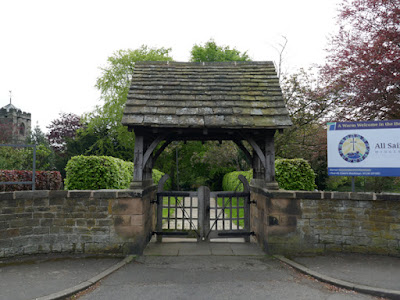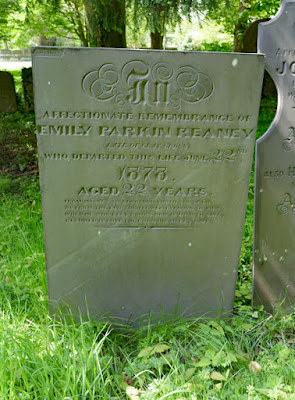Passing through the lychgate at All Saints church in Wingerworth, my first view of its churchyard was its western extension, where the headstones closest to me date back to the mid 1960’s, with pale grey granites and a medium grained sandstone, which is probably Stancliffe Darley Dale, being the most common materials.
Although I had spent quite a lot of time looking at various headstones earlier in the year, for the Bolsterstone Graveyard Project and the "Let’s talk about the stones” walk at Moorgate Cemetery, I didn’t go and have a close look but I could still see that many more recent headstones in the distance are made of ‘black granite’ – a material that has become very popular since cheap materials have been imported from India and China.
Stopping very briefly to photograph a grey/blue slate plaque that may be Kirkby slate from Cumbria, at the Garden Of Remembrance, I then came across a couple of large Georgian headstones, dated 1807 and 1812. These are single and double headstones respectively, but they have the same basic design and are presumably made by the same memorial mason, although I didn’t notice any maker’s name.
When helping my friend Catherine with the identification of stones that she was encountering while undertaking the Bolsterstone Gravestone Project, she drew my attention to these maker’s names or initials, which are usually very discreetly placed.
On the headstones of Emily Parkin Reaney (d.1878) and John Parkin (d.1877), which I think are Swithland slate from Leicestershire, the inscriptions recording J. Wright of Danesmoor as the maker is surprisingly cut into the face of the stone, albeit in small lettering at the top of the stone.
Compared to the bold lettering and numbering and the magnificent flourishes and swirls that accompany some of the letters, these pale into insignificance. A Wright Stone Services still operates in Danesmoor, which may have some family connection with this J. Wright, whose work can also be seen in the sandstone headstone of Joseph Mirfin (d.1878).
I next encountered a large cross, surrounded by iron railings, which looks like a war memorial but is in fact the memorial to Frederick Charles George FitzClarence-Hunloke (d.1878) and his wife, the Hon. Adelaide Augusta Wilhelmina Hunloke (d.1904), who was further commemorated by the insertion of a new window by Clayton and Bell into the east end of the church.
Continuing my walk around the oldest part of the churchyard that surrounds the church, I discovered a cluster of four squat headstones whose various details I couldn’t read, but which the church guide says all date to the C17.
I didn’t look closely at these, but I think that they are made out of a medium to coarse grained sandstone, rather than the flaggy sandstone used for the larger traditional headstones that I had previously seen. - as is the small headstone of Joseph Withers, where no date can be seen.
Opposite the south door, there is the socket stone of what the church guide considers to be an Anglo-Saxon preaching cross, but it is not recorded as a Listed Building or a Scheduled Monument, which is unusual for a supposed ancient structure like this.
My exploration of the churchyard was only very brief and most of the headstones that I saw are made out of a flaggy sandstone that could be from the Wingfield Flags which, like their near equivalent formations - the Greenmoor Rock and the Elland Flags - further to the north, was suitable for paving stones and presumably headstones.
The tomb of John Gratton (d.1882), which is in the form of a hipped raised slab, is one of the few exceptions to this. This dark grey granite looks like the Rubislaw variety from Aberdeen in Scotland, which was widely used in later Victorian banks, other prestigious buildings and substantial monuments throughout Britain.
The weathered medium grained sandstone headstone to Ann Howson, with its winged cherub, hourglass and skull, also does not have a date visible. Although I am far from being an expert in funerary symbolism, calligraphy and letter cutting styles. I have seen many headstones from the reign of King George I and King George II – 1714-1760 - at Hill Top Chapel in Attercliffe and All Saints churchyard in Darton and I think that this probably also dates to the C17.
The sandstone headstone to the son of William Ivory Fletcher is very badly weathered, with it being impossible to make out all the details of the epitaph, although it looks like he died in 1846. The makers name, J. Fletcher can be seen on the side of the headstone, where the delamination of the flaggy sandstone along the bedding planes, which can be clearly seen, will probably cause the headstone to fail completely in the not too distant future.
I finished my very quick walk around the part of the churchyard to the west side of the new extension to the church, where most of the headstones that I could see date back to the 1940’s and 1950’s. Here, grey granite from the Cornubian batholith in Cornwall/Devon and medium grained uniformly light brown sandstone, again probably Stancliffe Darley Dale, are the most common materials used during this period.
















No comments:
Post a Comment